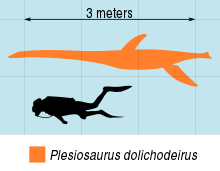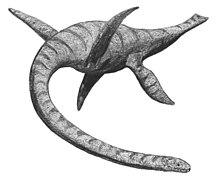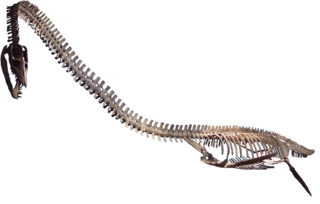
Elasmosaurus is a genus of plesiosaur that lived in North America during the Campanian stage of the Late Cretaceous period, about 80.5 million years ago. The first specimen was discovered in 1867 near Fort Wallace, Kansas, US, and was sent to the American paleontologist Edward Drinker Cope, who named it E. platyurus in 1868. The generic name means "thin-plate reptile", and the specific name means "flat-tailed". Cope originally reconstructed the skeleton of Elasmosaurus with the skull at the end of the tail, an error which was made light of by the paleontologist Othniel Charles Marsh, and became part of their "Bone Wars" rivalry. Only one incomplete Elasmosaurus skeleton is definitely known, consisting of a fragmentary skull, the spine, and the pectoral and pelvic girdles, and a single species is recognized today; other species are now considered invalid or have been moved to other genera.

The Plesiosauria or plesiosaurs are an order or clade of extinct Mesozoic marine reptiles, belonging to the Sauropterygia.
Liopleurodon is an extinct genus of large, carnivorous marine reptile belonging to the Thalassophonea, a clade of short-necked pliosaurid plesiosaurs. Liopleurodon lived from the Callovian Stage of the Middle Jurassic to the Kimmeridgian stage of the Late Jurassic Period. It was the apex predator of the Middle to Late Jurassic seas that covered Europe. The largest species, L. ferox, is estimated to have grown over 6 metres (20 ft) in length based on a large skull.

Macroplata is an extinct genus of Early Jurassic rhomaleosaurid plesiosaur which grew up to 4.65 metres (15.3 ft) in length. Like other plesiosaurs, Macroplata probably lived on a diet of fish, using its sharp needle-like teeth to catch prey. Its shoulder bones were fairly large, indicating a powerful forward stroke for fast swimming. Macroplata also had a relatively long neck, twice the length of the skull, in contrast to pliosaurs.

Elasmosauridae is an extinct family of plesiosaurs, often called elasmosaurs. They had the longest necks of the plesiosaurs and existed from the Hauterivian to the Maastrichtian stages of the Cretaceous, and represented one of the two groups of plesiosaurs present at the end of the Cretaceous alongside Polycotylidae.
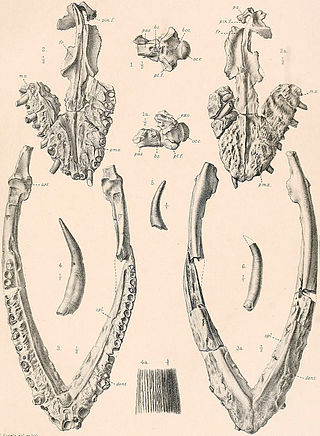
Muraenosaurus is an extinct genus of cryptoclidid plesiosaur reptile from the Oxford Clay of Southern England. The genus was given its name due to the eel-like appearance of the long neck and small head. Muraenosaurus grew up to 5.2 metres (17 ft) in length and lived roughly between 160 Ma and 164 Ma in the Callovian of the middle Jurassic. Charles E. Leeds collected the first Muraenosaurus which was then described by H. G. Seeley. The specimen may have suffered some damage due to the casual style of Charles Leeds’ collection. The first muraenosaur was recovered with pieces missing from the skull and many of the caudal vertebrae absent. Because the animal was described from Charles Leeds’ collection it was given the name Muraenosaurus Leedsi. M. leedsi is the most complete specimen belonging to the genus Muraenosaurus and also the only species that is undoubtedly a member of the genus. Two other species have been tentatively referred to as members of the genus Muraenosaurus: M. reedii and Muraenosaurus beloclis Seeley 1892, which in 1909 became the separate genus Picrocleidus.
Peloneustes is a genus of pliosaurid plesiosaur from the Middle Jurassic of England. Its remains are known from the Peterborough Member of the Oxford Clay Formation, which is Callovian in age. It was originally described as a species of Plesiosaurus by palaeontologist Harry Govier Seeley in 1869, before being given its own genus by naturalist Richard Lydekker in 1889. While many species have been assigned to Peloneustes, P. philarchus is currently the only one still considered valid, with the others moved to different genera, considered nomina dubia, or synonymised with P. philarchus. Some of the material formerly assigned to P. evansi have since been reassigned to "Pliosaurus" andrewsi. Peloneustes is known from many specimens, including some very complete material.

Thalassiodracon (tha-LAS-ee-o-DRAY-kon) is an extinct genus of plesiosauroid from the Pliosauridae that was alive during the Late Triassic-Early Jurassic (Rhaetian-Hettangian) and is known exclusively from the Lower Lias of England. The type and only species, is Thalassiodracon (Plesiosaurus) hawkinsi.

Leptocleidus is an extinct genus of plesiosaur, belonging to the family Leptocleididae. It was a small plesiosaur, measuring only up to 3 m (9.8 ft).
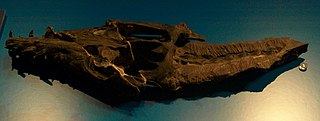
Augustasaurus is a genus of aquatic sauropterygian reptile belonging to the Pistosauria, a clade containing plesiosaurs and their close relatives. Pistosaurus and Augustasaurus were thought to be the only known members of the family Pistosauridae. However, some recent cladistic analyses found Augustasaurus to be a more advanced pistosaur, as a sister group of the order Plesiosauria. The only known species of Augustasaurus is Augustasaurus hagdorni, which was first described in 1997.

Eretmosaurus is an extinct genus of plesiosaur from the Early Jurassic Blue Lias of England. Only the type species is known, which is E. rugosus.

Sthenarosaurus is an extinct genus of rhomaleosaurid pliosauroid discovered in the Toarcian-aged 'Main Alum Shale' in Whitby, England. The type species, S. dawkinsi, was named and described in 1909. The type specimen is MMUM LL 8023, a set of postcrania discovered in Whitby. Other indeterminate specimens are known, including a pectoral girdle described in 1911.

Plesiopterys is an extinct genus of plesiosaur originating from the Posidonienschiefer of Holzmaden, Germany, and lived during the Early Jurassic period. It is thought to be the sister taxon to all other plesiosauroids including the Plesiosaurus, and is placed outside of the Plesiosauroidea group. Plesiopterys wildi is the one known species within the genus, and is 220 centimeters long, or about 7.2 feet, and its body and skull are both relatively small. It possesses a unique combination of both primitive and derived characters, and is currently displayed at the State Museum of Natural History, Germany.

Avalonnectes is an extinct genus of small-bodied rhomaleosaurid known from the Early Jurassic period of the United Kingdom. It contains a single species, A. arturi.

Stratesaurus is an extinct genus of small-bodied rhomaleosaurid plesiosaur known from the Early Jurassic period of the United Kingdom. It contains a single species, S. taylori. It was a small plesiosaur, with a skull length of 18 cm (7.1 in) and a body length of 2 m (6.6 ft).

Eoplesiosaurus is an extinct genus of basal plesiosauroid known from the Early Jurassic period of the United Kingdom. It contains a single species, E. antiquior.
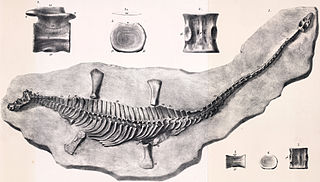
Microcleididae is an extinct family of basal plesiosauroid plesiosaurs from the Early Jurassic of France, Germany, Portugal and the United Kingdom. Currently, the oldest and the most known microcleidid is Eretmosaurus from the middle Sinemurian of the United Kingdom. Microcleididae was formally named and described by Roger B. J. Benson, Mark Evans and Patrick S. Druckenmiller in 2012.

Anningasaura is an extinct genus of basal plesiosaur. It is known from a single type species, A. lymense, discovered in Early Jurassic rocks of Lyme Regis in the United Kingdom.

This timeline of plesiosaur research is a chronologically ordered list of important fossil discoveries, controversies of interpretation, taxonomic revisions, and cultural portrayals of plesiosaurs, an order of marine reptiles that flourished during the Mesozoic Era. The first scientifically documented plesiosaur fossils were discovered during the early 19th century by Mary Anning. Plesiosaurs were actually discovered and described before dinosaurs. They were also among the first animals to be featured in artistic reconstructions of the ancient world, and therefore among the earliest prehistoric creatures to attract the attention of the lay public. Plesiosaurs were originally thought to be a kind of primitive transitional form between marine life and terrestrial reptiles. However, now plesiosaurs are recognized as highly derived marine reptiles descended from terrestrial ancestors.
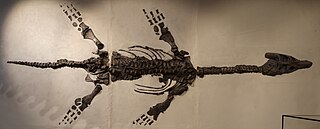
Atychodracon is an extinct genus of rhomaleosaurid plesiosaurian known from the Late Triassic - Early Jurassic boundary of England. It contains a single species, Atychodracon megacephalus, named in 1846 originally as a species of Plesiosaurus. The holotype of "P." megacephalus was destroyed during a World War II air raid in 1940 and was later replaced with a neotype. The species had a very unstable taxonomic history, being referred to four different genera by various authors until a new genus name was created for it in 2015. Apart from the destroyed holotype and its three partial casts, a neotype and two additional individuals are currently referred to Atychodracon megacephalus, making it a relatively well represented rhomaleosaurid.



